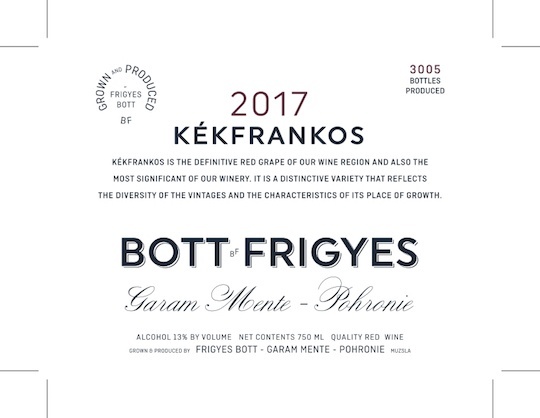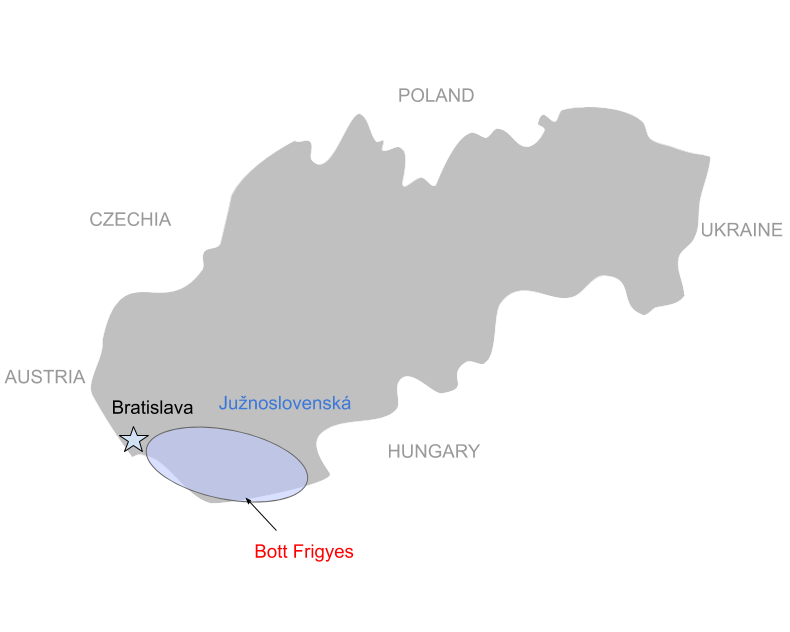2018 Bott Frigyes Kékfrankos
Južnoslovenská, Slovakia

After WWI, Hungary lost around 71% of its territory to Romania, Ukraine, Czechoslovakia (Slovakia), Yugoslavia (Slovenia, Croatia, Serbia) and Austria. Over 3 million ethnic Hungarians found themselves outside of Hungary with significant outcome on the grapes and traditions that never stopped or are now coming back to life beyond the present day borders of Hungary. On the southern slopes of the Mužsla Hills in Slovakia surrounded by the river Garam, Danube and the Ipoly rivers, is one such example: Bott Frigyes. Even the neighboring village of Béla is where Judit and József Bodó of Bott Pince began their winemaking career (ethnically Hungarian but born in Slovakia) before moving to Tokaj. Long story short, a whole bunch of things all came together with Bott Frigyes coupled with great farming, honest winemaking, and delicious wines.
VINEYARDS
Bott and his son Frici cultivate 10 hectares of vineyards next to the River Garam, at 250 metres above sea level. They are growing Furmint, Hárslevelű (Lipovina in Slovakia), Juhfark, Kékfrankos, Kadarka (cuttings are incidentally from Balla Géza in Romania who is also ethnically Hungarian), Tramini, Pinot Blanc, Sauvignon Blanc, Pinot Noir, Riesling, Sárfahér and Olaszrizling. The soil is clay on top of volcanic bedrock, which is also rich in limestone and minerals.
WINE MAKING
The winemaking is certainly structured in terms of technique, although all fermentations are native, there’s zero temperature control, longer lees aging, natural settling, all oak barrel (some amphora), and bottling unfined and unfiltered with a small amount of SO2 at bottling as the only addition. For the reds, they do use the “Hamburger” method which is essentially alternating layers of whole cluster (foot stomped), topped with whole cluster, then topped with a destemmed and hand crushed layer. This achieves a semi-carbonic quality to the wines without developing too much of the banana or bubble gum often associated with carbonic. For the skin contact whites, it’s often no more than a week, and they are careful to keep it worked over to prevent VA and other flaws. The winemaking overall is tied to tradition but with a nod to modern hygiene in the cellar.
NOTES & PAIRINGS
Sitting along the Danube and tasting barrel samples of the 2018 reds, the Kékfrankos as Bott puts it is, “The main message from our region.” It has the history and flavor that make it inextricable from the area. Through clonal selection, controlling vigor with cover crops, and farmed with Biodynamic principles, the berries are small and thick skinned. They then use the “Hamburger method” which is foot stomped whole clusters, topped with whole cluster, then topped with a destemmed and hand crushed layer. There’s a touch of that whole cluster fruit, aromatics from the stems, and plenty of spice from the skins.
ANALYTICS & PRONUNCIATION
PRODUCER: Bott Frigyes
APPELLATION: Južnoslovenská
VINTAGE: 2018
GRAPE COMPOSITION: 100% Kékfrankos
CLIMATE: Continental (hot summers & cold winters)
SOILS: clay on top of volcanic bedrock
ALCOHOL: 13.5%
RESIDUAL SUGAR: 2.2 g/l
ACIDITY: 6.08 g/l
